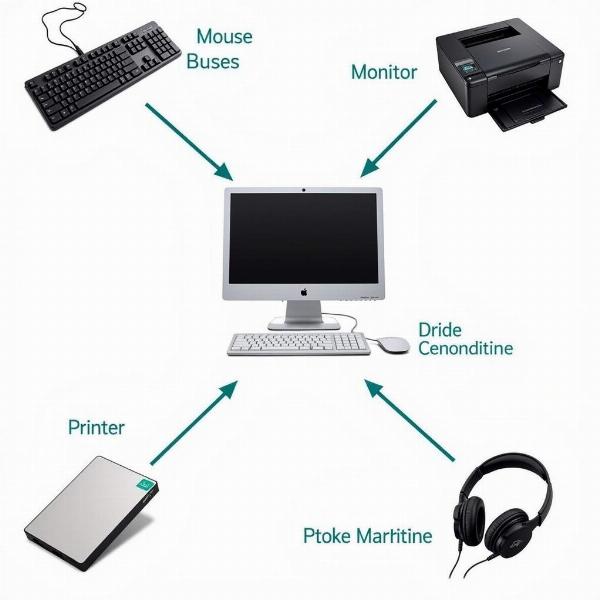Understanding the meaning of “peripheral devices” is crucial in today’s digitally driven world, especially for Hindi speakers navigating the ever-evolving landscape of technology. Simply put, peripheral devices are external components that connect to a computer, enhancing its functionality and allowing us to interact with it more effectively. This article delves into the meaning, types, and importance of peripheral devices in Hindi, providing a comprehensive overview for anyone seeking to understand this essential aspect of computing.
What are Peripheral Devices? (परिधीय उपकरण क्या हैं?)
Peripheral devices, known as परिधीय उपकरण (paridhiy upakaran) in Hindi, are essentially external hardware components that connect to a computer system to expand its capabilities. These devices are not part of the core computer architecture, which includes the CPU, motherboard, and memory. Instead, they supplement these core components, enabling users to perform a wider range of tasks and interact with the computer in various ways. Think of them as extensions of your computer’s brain, allowing it to “see,” “hear,” and “touch” the digital world.
 Examples of Peripheral Devices
Examples of Peripheral Devices
Types of Peripheral Devices (परिधीय उपकरणों के प्रकार)
Peripheral devices are broadly categorized into input, output, storage, and networking devices. Each type plays a distinct role in facilitating communication between the user and the computer.
Input Devices (इनपुट डिवाइस)
Input devices allow us to feed data and instructions into the computer. Common examples include:
- Keyboard (कीबोर्ड): Used for typing text, numbers, and commands.
- Mouse (माउस): Enables cursor control and interaction with graphical elements.
- Microphone (माइक्रोफ़ोन): Captures audio input for voice commands, recordings, and communication.
- Scanner (स्कैनर): Converts physical documents and images into digital format.
- Webcam (वेबकैम): Captures video and still images for video conferencing and other applications.
Output Devices (आउटपुट डिवाइस)
Output devices display or present information processed by the computer. These include:
- Monitor (मॉनिटर): Displays visual output, including text, images, and videos.
- Printer (प्रिंटर): Produces hard copies of documents and images.
- Speakers (स्पीकर): Outputs audio signals, allowing us to hear sounds and music.
- Projector (प्रोजेक्टर): Projects images and videos onto a larger screen or surface.
Storage Devices (स्टोरेज डिवाइस)
Storage devices store data and information for later retrieval. Examples include:
- Hard Disk Drive (HDD) (हार्ड डिस्क ड्राइव): A non-volatile storage device that stores data magnetically.
- Solid State Drive (SSD) (सॉलिड स्टेट ड्राइव): A faster and more durable storage device that uses flash memory.
- USB Flash Drive (यूएसबी फ्लैश ड्राइव): A portable storage device that connects via USB.
- External Hard Drive (बाहरी हार्ड ड्राइव): A portable HDD or SSD that provides additional storage capacity. See our article on wireless meaning in hindi for more information on wireless storage options.
Networking Devices (नेटवर्किंग डिवाइस)
Networking devices facilitate communication between computers and other devices, enabling internet access and data sharing. These include:
- Router (राउटर): Directs network traffic between devices and the internet.
- Modem (मॉडेम): Connects to the internet service provider and provides internet access.
- Network Interface Card (NIC) (नेटवर्क इंटरफ़ेस कार्ड): Enables a computer to connect to a network.
Importance of Peripheral Devices (परिधीय उपकरणों का महत्व)
Peripheral devices are essential for utilizing a computer effectively. They allow us to interact with the digital world in meaningful ways, perform various tasks, and access information efficiently. Imagine trying to use a computer without a keyboard, mouse, or monitor – it would be virtually impossible!
Conclusion
Peripheral devices, or परिधीय उपकरण, are the unsung heroes of the computing world. They bridge the gap between us and our computers, enabling us to perform a vast array of tasks and unlock the full potential of our digital tools. Understanding their types and functions is crucial for anyone seeking to navigate the modern technological landscape effectively.
FAQs
- What is a peripheral device in simple terms? A peripheral device is any external hardware that connects to a computer to expand its functionality.
- What are the main types of peripheral devices? The main types are input, output, storage, and networking devices.
- Why are peripheral devices important? They enable us to interact with computers, perform tasks, and access information.
- Is a printer a peripheral device? Yes, a printer is an output peripheral device.
- Is a hard drive a peripheral device? While internal hard drives are core components, external hard drives are considered peripheral devices.
- What are some examples of input devices? Keyboard, mouse, microphone, scanner, and webcam.
- What are some examples of output devices? Monitor, printer, speakers, and projector.
Meaning-Hindi.in is your trusted partner for accurate and culturally sensitive Hindi translation services. We specialize in various domains, including business, legal, technical, website localization, educational, and specialized translations. Need help understanding technical documentation like user manuals for peripheral devices? Contact us at [email protected] or call us at +91 11-4502-7584. Meaning-Hindi.in is here to bridge the language gap for you.